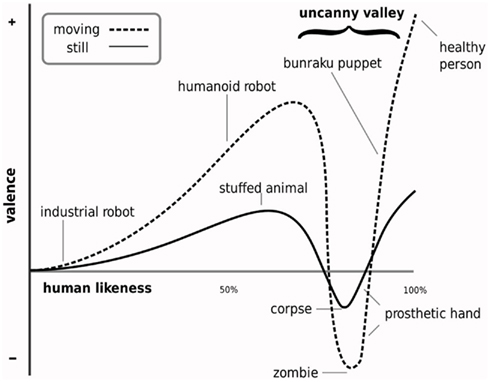I first learned about the concept of the Uncanny Valley in a class I took with Professor Kirsh (psychology) called Parenting in the Zombie Apocalypse. One of the very first things we covered was why zombies, and other monsters found in the genre of horror, are scary to us. Besides their physical danger to living humans and their mindless pursuit of wiping out all of humanity, zombies are simply creepy because their appearance falls in the Uncanny Valley.
The Uncanny Valley is a concept created by a Japanese roboticist named Masahiro Mori. When we first started developing human-like robots and lifelike animation, one of the first things people began to notice is how creepy these humanoids are, to the point where it is a real problem in the animation industry. Think of movies like the Polar Express- despite the cute story and wholesome message, the animation style is vaguely unnerving in its devotion to realism. Recent pop-culture phenomenon Sophia the Robot (who has been given the status of a legal person) is also creepy (in my opinion) because she is incredibly humanoid, but there’s something just not quite right about her.
Why exactly are we scared by not-quite human-like figures? In Professor Kirsh’s class, it was hypothesized that it could be an evolutionary survival mechanism – people who don’t look right might be carrying an illness and thus should be avoided, and this is how we classify animated or robotic beings. Corpses (which also fall in the uncanny valley) pose a danger as well, both for reasons of sickness and of the possibility of whatever killed them still being around. Zombies certainly fall into both of these categories, as do vampires and other human-like monsters. Robots are a little bit different because of the issue of agency – it has been suggested that robots are creepy because they suggest intelligence and a lack of emotion to go with that intelligence.


Coming back to Jemisin, in our class discussion about Charles Cordier, my group talked about how we all assumed the stone eaters were white because of classical Greek statues and the Renaissance artists who emulated them. When it was pointed out to us that the original Greek statues were painted, we looked up what they looked like, and my immediate reaction was that they looked worse painted. Adding to my discomfort is the fact that their eyes were made separately and most statues in museums don’t have their eyes.
In writing this post, I came across a blog post by author Adam Kotsko, who wrote about how thankful he is that Renaissance artists didn’t know that Greek statues were painted because these new artists emulated Greek statues and achieved even higher levels of realism in their sculpture. Writes Kotsko, “A version of Michelangelo’s David that was painted as accurately as it is sculpted would, I submit, be utterly unbearable to look at. It would be too real. Only the abstraction of color allows the accuracy of the sculpture to provoke wonder rather than horror.” He goes on to talk about Bernini’s statue Rape of Proserpina, and I completely agree with his analysis- a realistically painted version of this already hard to look at sculpture would be horrific, not beautiful.
Perhaps this is why the stone eaters are so disquieting – statues are already a little uncanny valley-like and used to be much more so when they were painted. The idea of these things being able to move and talk and think – this is utterly alien and deeply unnerving, which is exactly what my initial reaction was to the stone eaters.
In the blog post we read about Jemisin’s creation of races, she writes “I tried to write the stone eaters as basically mythological creatures sans mythology, or regarding whom the mythology was all but useless. Usually, when I see this in fiction, the creatures read as monsters. Without the cushioning effect of folklore, the creatures become too alien and frightening, or pitiful, to embrace as fellow people.” At first, I thought she had created something too strange, too inhuman and yet too close to human – something too deep in the uncanny valley for comfort. Our first introduction to a stone eater in The Fifth Season alludes to this. Writes Jemisin, “When she turns to the man – slowly; stone eaters are slow aboveground, except when they aren’t – this movement pushes her beyond artful beauty into something altogether different. The man has grown used to it, but even so, he does not look at her. He does not want revulsion to spoil the moment” (6).
And yet, over the course of a book and a half, Jemisin has completely changed my attitude toward them. Alabaster’s telling of the stone eaters’ perspectives, where they come from, how they have even forgotten who they are – it is so incredibly humanizing that it overcame the uncanny valley. When Jemisin writes, “But you can think of Hoa in that moment. Being fascinated by soap. Curling against you to sleep. His sorrow, when you stopped treating him like a human being,” it is so essentially human that I couldn’t help but feel sorrow for a being I never thought I could understand (The Obelisk Gate 167).
At the end of the aforementioned blog post, Jemisin wonders if she will be able to humanize the stone eaters. In my opinion, she has more than succeeded.

